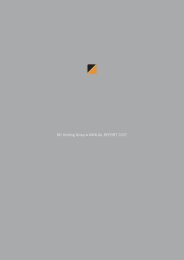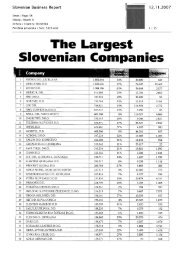The Group KD Group and KD Group dd
The Group KD Group and KD Group dd
The Group KD Group and KD Group dd
You also want an ePaper? Increase the reach of your titles
YUMPU automatically turns print PDFs into web optimized ePapers that Google loves.
<strong>The</strong> <strong>Group</strong> <strong>KD</strong> <strong>Group</strong> Annual Report 2009<br />
Notes to Consolidated Financial Statements as at <strong>and</strong> for the year ended 31 December 2009<br />
As already mentioned, in 2009 we increased our own shares for motor insurance <strong>and</strong> insurance against the risk of natural<br />
disasters, which directly affects the reduced volume of reinsurance coverage compared to the contract year 2008. Loss<br />
events in the two years are comparable since in both years we recorded more loss events due to storms <strong>and</strong> an equal<br />
number of major automobile liability claims. In contract year 2008, the above claims would cause decrease in the <strong>Group</strong>’s<br />
profit of EUR 3,679 thous<strong>and</strong>, <strong>and</strong> in 2009, EUR 4,003 thous<strong>and</strong>.<br />
5.2 Financial risks<br />
<strong>The</strong> <strong>Group</strong> is exposed to financial risks through its financial assets <strong>and</strong> liabilities, reinsurance receivables <strong>and</strong> insurance<br />
liabilities. Financial risks are risks that, due to changes in the capital markets <strong>and</strong> ratings of the <strong>Group</strong>’s clients, the inflows will<br />
not be sufficient to cover the outflows. <strong>The</strong> most significant components of this financial risk are liquidity risk, credit risk <strong>and</strong><br />
market risk; the <strong>Group</strong> is exposed to the risks of changes in interest rates, securities market prices <strong>and</strong> currency rates.<br />
Liquidity risk is the risk that the <strong>Group</strong> may be unable to repay all its liabilities, including potential liabilities, without threat to its<br />
normal activities. <strong>The</strong> <strong>Group</strong> maintains capital adequacy with an adequate amount of capital in order to be able to ensure<br />
liquidity at any moment <strong>and</strong> so that it is sustainably able to meet its obligations (solvency).<br />
<strong>The</strong> main source of credit risk for the <strong>Group</strong> stems from the insurance segment <strong>and</strong> involves investments <strong>and</strong> reinsurance<br />
risks. This involves the risk that the counterparty will be unable to pay the amounts due at maturity.<br />
Market risks arise particularly in the investment of assets, where there is the potential that expectations regarding the value of<br />
investments are not met or are not met entirely. <strong>The</strong> risk of unfavourable changes in investment values can be the<br />
consequence of foreign exchange rate changes, as well as changes in interest rates or securities prices.<br />
<strong>The</strong> <strong>Group</strong> manages <strong>and</strong> controls the risks to which it is exposed by constantly monitoring cash flows <strong>and</strong> ensuring that it<br />
always has enough liquid assets at its disposal to settle its liabilities, by investing its assets in a manner which ensures stable<br />
long-term returns which exceed the amount of returns on insurance liabilities, by matching the terms of financial assets<br />
against financial liabilities, <strong>and</strong> by ensuring the adequacy of financial assets.<br />
Currency risk is less important for the <strong>Group</strong> because of ERM2 <strong>and</strong> adoption of the euro in 2007.<br />
125







